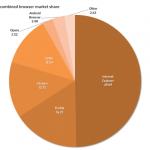
 Meet Radiant Fabrication’s Lionhead Bunny. Radiant Fabrication We’ve told you about inexpensive 3D printers. We’ve reported on the first two 3D scanners. And recently, Ars editor Lee Hutchinson took two 3D printers for a spin to reveal what he called a “ maddening journey into another dimension .” But get ready to set aside those old-timey devices—enter the all-in-one 3D printers and scanners . This week, two companies have each announced their own all-in-one 3D printer and scanner. On Tuesday, Radiant Fabrication trumpeted the Lionhead Bunny, a $1, 649 device that the company will make available starting next month (though it appears to be dependent on the success of its forthcoming Kickstarter campaign). In a statement released with its announcement, Radiant Fabrication wrote: Read 2 remaining paragraphs | Comments
Meet Radiant Fabrication’s Lionhead Bunny. Radiant Fabrication We’ve told you about inexpensive 3D printers. We’ve reported on the first two 3D scanners. And recently, Ars editor Lee Hutchinson took two 3D printers for a spin to reveal what he called a “ maddening journey into another dimension .” But get ready to set aside those old-timey devices—enter the all-in-one 3D printers and scanners . This week, two companies have each announced their own all-in-one 3D printer and scanner. On Tuesday, Radiant Fabrication trumpeted the Lionhead Bunny, a $1, 649 device that the company will make available starting next month (though it appears to be dependent on the success of its forthcoming Kickstarter campaign). In a statement released with its announcement, Radiant Fabrication wrote: Read 2 remaining paragraphs | Comments
See original article:
Meet the new hotness: All-in-one 3D printers and scanners




 A major new patent bill, passed in a 117-4 vote by New Zealand’s Parliament after five years of debate, has banned software patents. The relevant clause of the patent bill actually states that a computer program is “not an invention.” Some have suggested that was a way to get around the wording of the TRIPS intellectual property treaty which requires patents to be “available for any inventions, whether products or processes, in all fields of technology.” Processes will still be patentable if the computer program is merely a way of implementing a patentable process. But patent claims that cover computer programs “as such” will not be allowed. Read 5 remaining paragraphs | Comments
A major new patent bill, passed in a 117-4 vote by New Zealand’s Parliament after five years of debate, has banned software patents. The relevant clause of the patent bill actually states that a computer program is “not an invention.” Some have suggested that was a way to get around the wording of the TRIPS intellectual property treaty which requires patents to be “available for any inventions, whether products or processes, in all fields of technology.” Processes will still be patentable if the computer program is merely a way of implementing a patentable process. But patent claims that cover computer programs “as such” will not be allowed. Read 5 remaining paragraphs | Comments 


